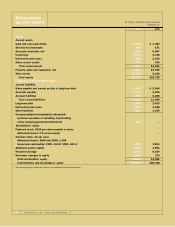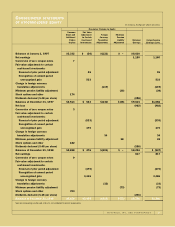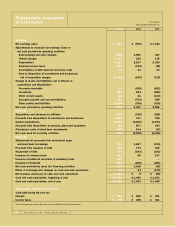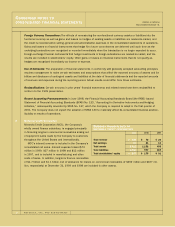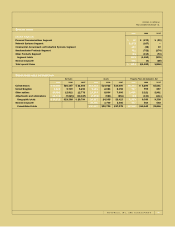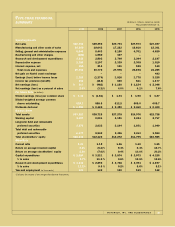Motorola 1999 Annual Report Download - page 29
Download and view the complete annual report
Please find page 29 of the 1999 Motorola annual report below. You can navigate through the pages in the report by either clicking on the pages listed below, or by using the keyword search tool below to find specific information within the annual report.
MOTOROLA, INC. AND SUBSIDIARIES 28
3. Information by Segment and Geographic Region
In July 1998, the Company’s communications-related businesses began realigning into the Communications Enterprise,
a structure intended to enable integrated solutions and improved responsiveness to the needs of distinct customer
segments. For the 1998 year-end reporting, the Company continued to use the previous segments because the
Company’s management made operating decisions and assessed per formance based on these segments. With the
completion of the realignment in 1999, the Company changed its segment reporting. Therefore, the Company has
restated previously repor ted segment information to reflect the realignment and to conform to the management approach
of Statement of Financial Accounting Standards No. 131, “Disclosures about Segments of an Enterprise and Related
Information,” which the Company implemented as of January 1, 1998.
The Company’s new reportable segments have been determined based on the nature of the products offered to
customers. The Personal Communications Segment focuses on delivering integrated voice, video and data communi-
cations solutions to consumers. This segment includes subscriber products and accessories for cellular, iDEN®radio,
paging, and satellite and consumer two-way radio markets. The Network Systems Segment focuses on providing total
system solutions for telecommunications carriers and operators. This segment includes the Company’s cellular infra-
structure, iDEN infrastructure and satellite communications infrastructure businesses. The Commercial, Government
and Industrial Systems Segment focuses on the commercial, governmental and industrial markets, providing integrated
communications solutions, including infrastructure and non-consumer two-way radio products. The Semiconductor
Products Segment continues to focus on the design, manufacture and distribution of integrated semiconductor solu-
tions and components. The Other Products Segment is comprised primarily of the Integrated Electronic Systems
Sector (which primarily manufactures and sells automotive and industrial electronics); the Internet and Networking
Group (which focuses on the development of servers, applications and internet solutions); the Network Management
Group (which continues to hold and manage investments in terrestrial and satellite-based network operators); and
other corporate programs.
The accounting policies of the segments are the same as those described in Note 1 Summary of Significant
Accounting Policies. Segment operating results are measured based on profit (loss) before income tax adjusted, if
necessary, for certain segment-specific items and corporate allocations. Intersegment and intergeographic sales are
accounted for on an arm’s length pricing basis. Intersegment sales included in adjustments and eliminations were
$2.7 billion, $2.8 billion and $3.2 billion for the years ended December 31, 1999, 1998 and 1997, respectively.
These sales were primarily from the Semiconductor Products Segment and the Integrated Electronic Systems Sector.
Intersegment sales from the Semiconductor Products Segment were $1.6 billion for the years ended December 31,
1999 and 1998, and $1.8 billion for the year ended December 31, 1997. For these same periods, intersegment sales
from the Integrated Electronic Systems Sector were $0.8 billion, $0.9 billion and $1.0 billion, respectively. Net sales
by geographic region are measured by the location of the revenue-producing operations.
Domestic export sales to third parties were $2.4 billion, $3.1 billion and $4.0 billion for the years ended December 31,
1999, 1998 and 1997, respectively. Domestic export sales to affiliates were $6.6 billion, $5.0 billion and $6.9 billion
for the years ended December 31, 1999, 1998 and 1997, respectively.
Identifiable assets (excluding intersegment receivables) are the Company’s assets that are identified with classes
of similar products or operations in each geographic region. General corporate assets include primarily cash and cash
equivalents, marketable securities, cost- and equity-based investments, the fair value adjustment of certain cost-based
investments and the administrative headquarters of the Company.
In 1999, 1998 and 1997, no single customer or group under common control represented 10% or more of the
Company’s sales.







